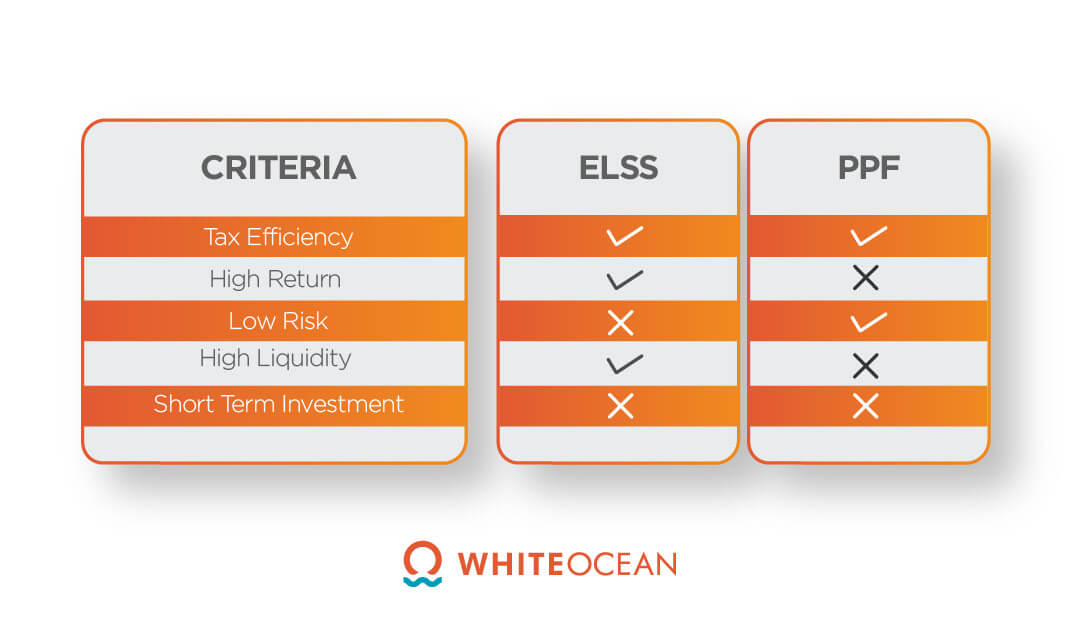
PPF or ELSS, which one suits you the best?

Taxes eat into a significant portion of your earnings, hence tax planning is important for you to ensure that you save and earn from it too while contributing your share to the country’s growth through taxes. And tax-saving investments like ELSS and PPF can help you reach your financial goals by maximising the tax relief provided under the Income Tax Act of 1961. Both provide tax savings as well as the possibility to earn profits on investment. This article compares ELSS mutual funds with PPF to help you decide which tax-saving strategy is best for you.
What Is ELSS?
ELSS or Equity Linked Savings Scheme is the only mutual fund covered by Section 80C of the Income Tax Act of 1961. Among all Section 80C choices, ELSS funds have the shortest lock-in time. Nonetheless, it provides a better opportunity for long-term wealth creation, and it is preferred by those with a higher risk tolerance.
A significant chunk invested in an ELSS goes into equity investments, and the returns are market-linked. As a result, the returns are affected by market volatility. In the long term, it has shown to be fruitful. The finest ELSS funds have outperformed other traditional vehicles like PPF and FD in terms of returns.
What Is PPF?
In 1968, the Indian government launched the Public Provident Fund (PPF) to encourage citizens to save and plan for their retirement. Except for NRIs, the scheme is open to all Indian nationals. You can also register a joint PPF account with a parent or legal guardian for a minor. Under Section 80C of the Income Tax Act, 1961, you can claim deductions of up to Rs.1,50,000 per year for investments made into your Public Provident Fund account. A PPF account must be locked in for a minimum of 15 years. After the lock-in term, you can extend it for another five years.
ELSS Vs PPF
 Benefits Of Investing In ELSS
Benefits Of Investing In ELSS
- Great Returns: Great Returns: ELSS has one of the highest returns in the tax-saving product category. ELSS schemes have earned anywhere between 11 to 14% returns over 3 and 5 year periods. ELSS returns, on the other hand, are market-linked and hence cannot be guaranteed.
- 80C Tax Benefits: Section 80C of the Income Tax Act, 1961 allows for tax deductions on ELSS investments up to Rs.1.5 lakh per year. Investing in ELSS can result in tax benefits of up to Rs. 46,800. ELSS returns, on the other hand, are taxable at 10% if the gain reaches Rs. 1 lakh in the year.
- Lowest Lock-in Period: ELSS investments have a 3 years lock-in period, making it a very liquid alternative. In just three years, you can cash out your ELSS fund investment.
- Options for SIP: The Systematic Investment Plan in ELSS allows you to begin investing with as little as Rs. 500 each month. The SIPs can be started and stopped whenever it is convenient for you. It gives you a lot of flexibility and convenience while making little but consistent investments.
Benefits Of Investing In PPF
- Low-Risk Vehicle: PPF contributions and returns are guaranteed by the government, making it one of the safest investment options in the country. Despite its low returns, PPF has been a very popular investment option because of its capital safety and returns.
- Great Tax Benefits: PPF investments fall into the exempt-exempt-exempt (EEE) category, which means that PPF contributions and returns are never taxed. Investors who make PPF deposits of up to Rs. 1.5 lakh are eligible for tax benefits under section 80C of the Income Tax Act. In addition, interest earned each month and the maturity amount is tax-free.
- Long term savings: The mandatory lock-in period for PPF deposits is 15 years. You can, however, obtain a loan on your PPF deposits from the third to sixth financial year after the account is opened. Furthermore, beginning in the sixth year, you can make a partial withdrawal, but only on certain predetermined grounds.
- Fixed Returns: Every year, PPF deposits earn you a fixed return in the form of interest. The government sets the interest rate on PPF on a quarterly basis. For the past five years, the average return on PPF has been roughly 7%.
- Minimum Investment: PPF allows you to invest as little as Rs 500 and as high as Rs 1.5 lakh. You can deposit money into your PPF account up to 12 times each year. Only a few exceptions, such as major illnesses, allow for early closure. Partial withdrawals are permitted after 5 years from the end of the year in which the account was opened.
The White Ocean Take
PPF and ELSS are both good tax-saving vehicles. As an investor, you must choose which one to invest in as per your investment goals. Consider how much risk you’re willing to face with your investment, as well as your investing horizon and amount. PPF is best suited for risk-averse individuals who can afford a 15-year lock-in term. ELSS is for investors who are willing to assume a moderate risk in exchange for higher returns. Staying invested for the long term is the greatest method to keep ELSS risk to a minimum.
Still confused? Worry not, get in touch with our financial and investment experts at White Ocean and let us guide you through your investment journey with the best options to invest in for your future. Drop us a hello at [email protected]



